Kathryn Root
What is Metabolism?
The human body requires energy to be able to stay alive and do basic daily tasks. This energy can come from food and drink, which includes carbohydrates, proteins, and fats. When food is broken down, the energy from these nutrients is used in chemical reactions to help the body function normally. This process is called metabolism and is made up of two parts: catabolism and anabolism (Better Health Channel, 2020).
How Does Metabolism Work?
The body’s metabolic rate consists of three components: Basal metabolic rate (BMR), thermic effect of food, and energy used during physical activity (Better Health Channel, 2020). BMR burns 50-80% of calories and men tend to use more energy in this part of metabolism. The thermic effect of food is the number of calories required to digest food and uses 5-10% of energy to do so (Better Health Channel, 2020). After eating, the body begins to break down food, generating heat and raising the BMR. During physical activity, the body uses 20% of calories depending on the type and amount of exercise (Better Health Channel, 2020). Calories burned during exercise are the only piece of metabolism that can be controlled depending on the amount of exercise a person does. Therefore, physical activity is important when trying to lose or maintain a healthy weight.
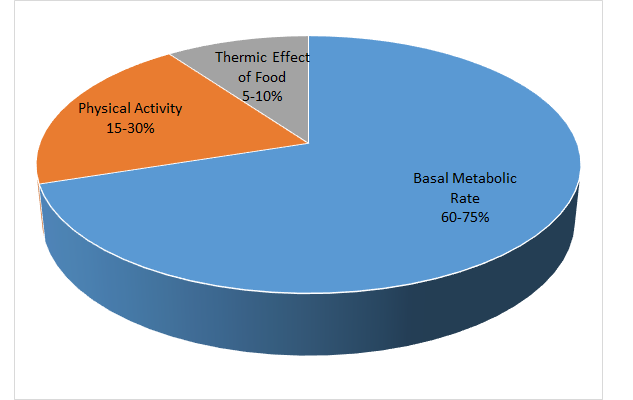
What Factors Affect Metabolism?
According to Better Health Channel (2020), BMR can be influenced by many modifiable and non-modifiable factors. Modifiable factors include diet, drug use, and amount of physical activity. Diet plays a large role in metabolism, but eating foods with less energy can slow down BMR to save energy. During exercise, the muscles in the body use a large amount of energy and may increase in size. More muscle can increase metabolism and cause the body to adapt to burn energy at a faster rate.
Nonmodifiable factors include age, genetics, and hormonal control (Better Health Channel, 2020). As age increases, changes in hormone levels and the brain occur. As a result, the body slowly loses muscle mass and the rate of metabolism decreases. Different genes can affect how much food a person eats. The FTO (Fat Mass and Obesity Associated) gene senses nutrient levels and controls hunger, which may affect weight gain (Goop, n.d.) According to Dr. Sara Gottfried, the PPARG gene creates fat cells, so too much of this gene can cause a person to gain weight (Goop, n.d.). Hormonal disorders in the thyroid gland can also increase or decrease the number of calories burned (Better Health Channel, 2020).
How Does Metabolism Differ Between Men and Women?
When examining the differences in metabolism, men normally have faster ones than women. This is due to their larger body size and muscle mass which requires more energy to maintain (National Health Service [NHS], 2020). However, there are more differences in how men use and store fat and other nutrients in the body. Women tend to have a greater amount of body fat than men even though their energy intake is smaller (Wu & O’Sullivan, 2011). This is because women are better at conserving energy and storing it as fat (Wu & O’Sullivan, 2011). Men store more of their fat in the abdominal area, putting them at a higher risk for diabetes, heart disease, and other conditions (Rogers, 2016). Since women have more slow-muscle twitch fibers, they burn more fat during exercise. However, men burn more fat after exercise possibly because of different hormones (Wu & O’Sullivan, 2011). To learn more about metabolism in men vs. women, click this link: Gender Differences in Metabolism
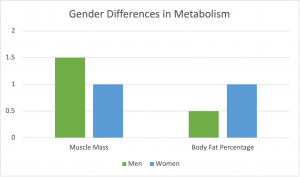
How Does Metabolism Affect Weight?
In order to maintain a healthy weight, people need to balance the number of calories they consume and burn (Harvard Health Publishing Harvard Medical School, 2015). When people consume less calories and burn more, they can lose weight. However, limiting food can cause the body to slow down metabolism and burn fewer calories over time, making weight loss harder (Harvard Health Publishing Harvard Medical School, 2015).
In order to lose weight and maintain a healthy metabolism, a person should do 3-5 days of moderate to high-intensity exercise per week (Vella & Kravitz, 2002). Moderate-intensity activities include biking, brisk walking, or dancing (National Health Service [NHS], 2019). High-intensity exercises include running, swimming, and sports (NHS, 2019). Women tend to use more fat during lower intensity exercises than men. Therefore, it may be better for men to do higher intensity workouts for a shorter period of time. This can increase the total amount of energy that comes from fat, so more energy is actually used (Vella & Kravitz, 2002). Since muscle burns more calories than fat, strength training can increase muscle and help in weight loss (NHS, 2020).
According to the National Health Service (2020), when people eat and drink more calories than they burn, they can gain weight. Since slow weight gain is better than fast weight gain, people should eat 300 to 500 more calories per day (Cleveland Clinic, 2020). Eating junk food can cause more weight gain in the belly, so foods high in calories and nutrients (i.e. nuts and seeds or lean meats) are better to achieve a healthy weight and prevent disease. Additionally, smaller meals every three to five hours can provide calories without feeling too full (Cleveland Clinic, 2020).
What Are Ways Someone Can Improve Their Metabolism?
A healthy metabolism is key to prevent diseases such as obesity, metabolic syndrome, and cardiovascular disease. According to the National Health Service (2020), 150 minutes of aerobic physical activity a week is the most effective way to boost metabolism. Sitting too often, especially with desk jobs, can burn fewer calories, reduce bone health, and increase the risk for weight gain (Gibbs et al., 2017). Therefore, it’s important to take a few minutes to stand up and move at work. Additionally, less sleep is linked to obesity and can disrupt hormones that help control weight (West, 2018). Poor sleep can increase appetite and disturb circadian rhythm as well (Newsom, 2020). This being said, it’s vital to get a good night’s sleep so metabolism is not disrupted.
Some foods may play a role in improving metabolism. Foods that contain iron, zinc, and selenium can help thyroid function (Petre, 2016). These foods include meats, seafood, and nuts. Protein-rich foods like eggs, milk, and grains can help with enzymes that do vital functions in the body (Petre, 2016). Legumes and pulses like peas also have amino acids that may increase the number of calories burned (Petre, 2016).
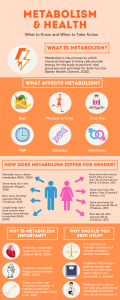
Chapter Review Questions
1. What is a way to maintain a healthy metabolism?
A. Exercise regularly
B. Consume less calories
C. Inadequate sleep
D. Take supplements to Improve metabolism
2. Which of the following is NOT a factor that affects metabolism?
A. Diet
B. Drug Use
C. Exercise
D. Time of meals
3. Why do men have a faster metabolism than women?
A. Men have more muscle mass
B. Women have more fast-muscle twitch fibers
C. Men burn more fat during exercise
D. Women require more energy to maintain their metabolism
References
Better Health Channel. (2020, April 30). Metabolism. https://www.betterhealth.vic.gov.au/health/conditionsandtreatments/metabolism#:~:text=Your%20metabolic%20rate%20is%20influenced,physical%20activity%20and%20hormone%20function.
Cleveland Clinic. (2020, September 15). High-calorie foods and snack ideas to gain weight. https://my.clevelandclinic.org/health/articles/16555-snack-ideas-for-weight-gain
Gibbs, B. B., Kowalsky, R. J., Perdomo, S. J., Grier, M. & Jakicic, J. M. (2017). Energy expenditure of deskwork when sitting, standing, or alternating positions. Occupational Medicine, 67(2), 121-127. https://doi.org/10.1093/occmed/kqw115
Goop. How to hack the genes that impact weight loss & metabolism. (n.d.). https://goop.com/wellness/health/how-to-hack-the-genes-that-impact-weight-loss-metabolism/
Harvard Health Publishing Harvard Medical School. (2015, July). Does metabolism matter in weight loss? https://www.health.harvard.edu/diet-and-weight-loss/does-metabolism-matter-in-weight-loss
Mandal, A. (2021, January 21). What is metabolism? News medical life sciences. https://www.news-medical.net/life-sciences/What-is-Metabolism.aspx
Newsom, R. (2020, October 9). Weight loss and sleep. Sleep Foundation. https://www.sleepfoundation.org/physical-health/weight-loss-and-sleep
National Health Service. (2019, October 8). Exercise. https://www.nhs.uk/live-well/exercise/
National Health Service. (2020, October 26). How can I speed up my metabolism? https://www.nhs.uk/live-well/healthy-weight/metabolism-and-weight-loss/
Nuckols, G. (2015, January 11). Gender differences in major markers of metabolic health. Stronger by Science. https://www.strongerbyscience.com/gender-differences-in-training-and-diet/
Petre, A. (2016, November 14). The 12 best foods to boost your metabolism. Healthline. https://www.healthline.com/nutrition/metabolism-boosting-foods#TOC_TITLE_HDR_2
Rogers, J. (2016, January 17). Gender differences in metabolism. Jefferson Regional Medical Center. https://www.jrmc.org/gender-differences-in-metabolism/#:~:text=About%2090%25%20of%20daily%20energy,and%20body%20size%2C%20not%20gender
Vella, C. A. & Kravitz, L. (2002) Gender differences in fat metabolism. IDEA Health and Fitness Source, 20(10), 36-46. https://www.unm.edu/~lkravitz/Article%20folder/genderdifferences.html
West, H. (2018, July 27). 10 easy ways to boost your metabolism (Backed by science). Healthline. https://www.healthline.com/nutrition/10-ways-to-boost-metabolism
Wu, B. N., & O’Sullivan, A. J. (2011). Sex differences in energy metabolism need to be considered with lifestyle modifications in humans. Journal of Nutrition and Metabolism, 2011, 391809. 10.1155/2011/391809
Introduction
Parkinson’s disease is a disease of the nervous system that causes the nerve cells, called neurons, to slowly break down or die. This is a slow-progressing disease that begins to cause symptoms over many years. When neurons break down, it results in a decrease in dopamine which can cause symptoms such as tremors of the body, stiff muscles, and difficulty thinking, writing, walking, or chewing (Mayo Foundation for Medical Education and Research, 2020b). These symptoms can make life very hard to live without help once they get past a certain point.
Causes and Risk Factors
The cause of Parkinson’s disease is unknown, but some genes have been linked to an increased chance for certain people. The X-chromosome contains a gene that affects how early Parkinson’s disease develops. Females have two X-chromosomes, whereas men have an X and a Y chromosome. A gene may not present itself physically when there is a second X-chromosome. This provides women with more protection against the disease compared to males. Therefore, this may be the reason Parkinson's develops earlier in males (Mata et al., 2015).
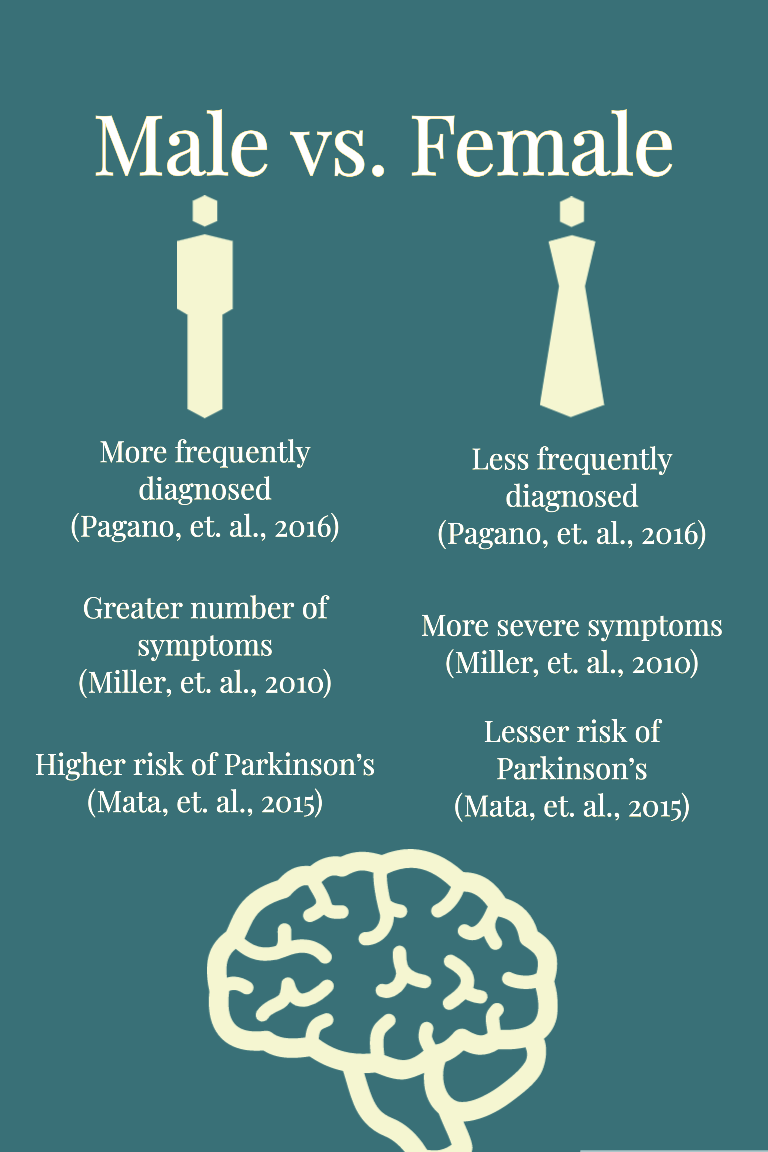
It is found that men are diagnosed more frequently than women. This could be because men are studied more often than women are, so the men have higher numbers (Pagano et al., 2016). Men also reported that they have more symptoms than women did, but they were not as severe as the females’ symptoms were. Though men have more symptoms, women are twice as likely to show tremors or have slowed movement than men are (Miller & Cronin-Golomb, 2010). Studies have also found that Parkinson's is the most prevalent in Caucasians compared to other ethnicities (Ben-Joseph et al., 2020). Age is also a large factor in who gets Parkinson’s disease. As individual ages, their risk for developing this disease increases (Mayo Foundation for Medical Education and Research, 2020b).
Pagano et al. (2016) found that the age group with the highest number of symptoms is those who are 60 to 69 years old. This age group showed the greatest number of symptoms at the time of diagnosis than others (Pagano et al., 2016). Other risk factors for developing Parkinson’s disease can include having a family member with the disease or being around herbicides and pesticides for long periods of time. While the pesticide and herbicide risk is small, there still needs to be more research to determine the impact (Mayo Foundation for Medical Education and Research, 2020b).
Signs and Symptoms
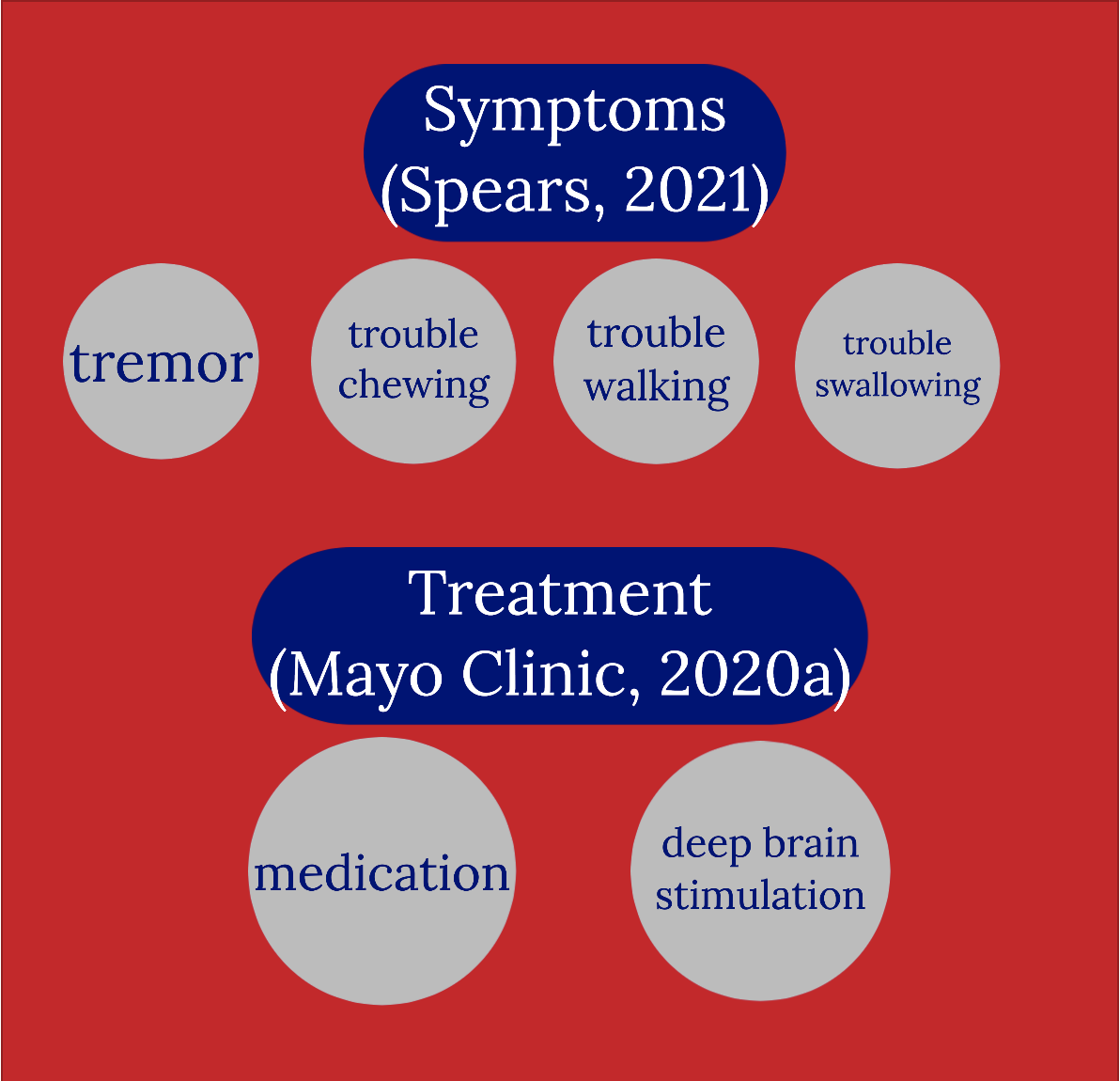
Though there is no sure way to prevent the disease, there are some early signs that can be checked for to ensure that the individuals are able to get treated quickly. The early signs are the presence of a tremor, trouble moving or walking around, chewing, or swallowing. These symptoms are due to the death of the neurons that control movement, called motor neurons. If anyone recognizes these signs, they must speak to their doctor or neurologist to get tested. When the individual gets diagnosed with Parkinson’s disease, their neurologist or doctor will begin a treatment plan for them, which may include a referral to a physical, occupational, or speech therapist to deal with some of the symptoms (Spears, n.d.).
Treatment
According to the Mayo Clinic (2020a) there is no cure for Parkinson's disease, however, there are a variety of treatments like medications and deep brain stimulation to slow the progression and severity of symptoms. Medications can be prescribed that help with the patient’s tremors, walking, and other movements. These medications will increase the level of a hormone called dopamine in the brain. This chemical is missing or is present in a lower amount when the neurons die, so the medications give it back to the brain. Deep brain stimulation uses electrodes in the patient’s brain that are connected to a generator in the chest that sends electricity to the brain. This surgery does not keep Parkinson’s disease from getting worse, it only helps the patient’s current symptoms. This surgery involves many risks like stroke, hemorrhage, or infections, so doctors don’t do it very often (Mayo Foundation for Medical Education and Research, 2020a).
Treatments for Parkinson's allow the patient to manage the severity and progression of their symptoms in order to help with pain or discomfort throughout life. Following diagnosis and treatment, the priority is palliative care to ensure that the patient is comfortable and has the highest quality of life possible (Mayo Foundation for Medical Education and Research, 2020a).
After looking at the symptoms, causes, treatments, and disparities, anyone who is concerned about themselves or others around them having Parkinson’s disease should be ready to go to a doctor if they show any of these symptoms or risk factors.
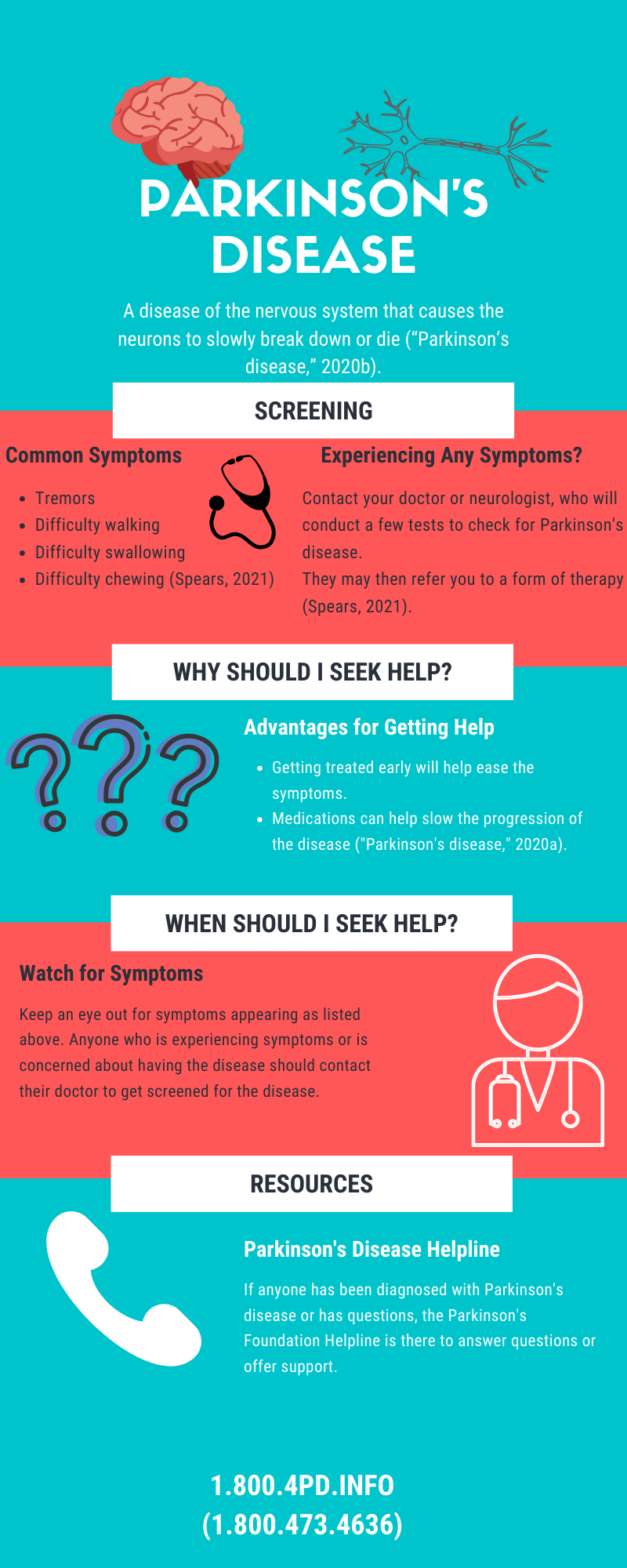
Chapter Review Questions
1. Parkinson's disease affects what type of body cell?
A. Nerve cells
B. Muscle cells
C. Immune Cells
D. Epithelial Cells
2. Which age group has the highest rate of diagnosis of Parkinson's disease?
A. 40-49 years old
B. 50-59 years old
C. 60-69 years old
D. 70-79 years old
3. Parkinson's disease lowers the level of what hormone in the brain?
A. Serotonin
B. Dopamine
C. Epinephrine
D. Oxytocin
References
Ben-Joseph, A., Marshall, C. R., Lees, A. J., & Noyce, A. J. (2020). Ethnic variation in the manifestation of Parkinson's disease: A narrative review. Journal of Parkinson's Disease, 10(1), 31–45. 10.3233/JPD-191763
Mata, I. F., Jang, Y., Kim, C.-H., Hanna, D. S., Dorschner, M. O., Samii, A., Agarwal, P., Roberts, J. W., Klepitskaya, O., Shprecher, D. R., Chung, K. A., Factor, S. A., Espay, A. J., Revilla, F. J., Higgins, D. S., Litvan, I., Leverenz, J. B., Yearout, D., Inca-Martinez, M., … Zabetian, C. P. (2015). The RAB39B p.G192R mutation causes x-linked dominant Parkinson's disease. Molecular Neurodegeneration, 10(1), 50. 10.1186/s13024-015-0045-4
Mayo Foundation for Medical Education and Research. (2020a, December 8). Parkinson's disease- diagnosis and treatments. Mayo clinic. https://www.mayoclinic.org/diseases-conditions/parkinsons-disease/diagnosis-treatment/drc-20376062#:~:text=Levodopa%2C%20the%20most%20effective%20Parkinson's,side%20effects%20such%20as%20nausea.
Mayo Foundation for Medical Education and Research. (2020b, December 8). Parkinson's disease- symptoms and causes. Mayo clinic. https://www.mayoclinic.org/diseases-conditions/parkinsons-disease/symptoms-causes/syc-20376055.
Miller, I. N., & Cronin-Golomb, A. (2010). Gender differences in Parkinson's disease: Clinical characteristics and cognition. Movement Disorders: Official Journal of the Movement Disorder Society, 25(16), 2695–2703. 10.1002/mds.23388
Pagano, G., Ferrara, N., Brooks, D. J., & Pavese, N. (2016). Age at onset and Parkinson's disease phenotype. Neurology, 86(15), 1400–1407. 10.1212/WNL.0000000000002461
Spears, C. (n.d.). 10 early signs of Parkinson's disease. Parkinson's Foundation. https://www.parkinson.org/understanding-parkinsons/10-early-warning-signs
either of a pair of complex endocrine organs near the anterior medial border of the kidney consisting of a mesodermal cortex that produces glucocorticoid, mineralcorticoid, and androgenic hormones and an ectodermal medulla that produces epinephrine and norepinephrine.
Is a blend of latex and fillers.

